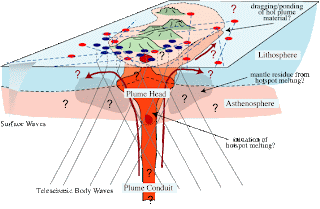The Hawaiian Islands
By Randy Rambo, Volcano, Hawaii, Saturday, April 16, 2011
By Randy Rambo, Volcano, Hawaii, Saturday, April 16, 2011
The Hawaiian Islands are best known today as the eight major islands located in the North Pacific Ocean.
The names of the eight major islands are: Hawaiʻi, Maui, Kahoʻolawe, Lānaʻi, Molokaʻi, Oʻahu, Kauaʻi and Niʻihau (looking southeast to northwest).
Actually, the Hawaiian Islands consist of a much longer "archipelago" or chain of islands. The archipelago consists of the eight major islands along with other atolls, small islets and seamounts that stretches a distance of 1500 miles across the Pacific Ocean, from the island of Hawaii at the southeastern end to Green Island in the Kure Atoll at the northwestern end of the chain.
The Hawaiian Islands get their name from the youngest island in the Hawaiian Island Chain called: "Hawaiʻi."
Each of the Hawaiian Islands also has a nickname. Hawaiʻi Island's nickname is: "The Big Island." It is called "The Big Island" because it is the biggest of all of the islands in the Hawaiian Island Chain.
How the Hawaiian Islands Were Made
All of the Hawaiian Islands were formed by mountains created by the eruptions of volcanoes.
Kilauea Volcano, Pu'u O'o Vent, August, 1984
(Puu_Oo_Aug_1984_from_www_solarviews_dot_com_fountain.jpg).An volcanic eruption is a place where hot melted rock called "magma" rises from deep inside the earth and erupts as "lava" out of the earth's crust.
The world has three main types of volcanoes: Shield, Cinder, and Composite.
The volcanoes in the Hawaiian Islands are Shield type volcanoes with long gentle slopes.
The world has three main types of volcanoes: Shield, Cinder, and Composite.
The volcanoes in the Hawaiian Islands are Shield type volcanoes with long gentle slopes.
Here is a diagram showing the main features of a volcano.
When liquid "magma" comes out of the earth, it is called "lava."
Lava:
(This is a photograph of a Kilauea Volcano lava flow on july 11, 2008).
In the case of the Hawaiian Islands, when hot liquid lava comes out of the earth from beneath the bottom of the ocean floor it meets the cold water and becomes solid new earth. The volcanic deposits of layer after layer of lava flows over time eventually form a solid mountain from the bottom of the sea floor. After many thousands of eruptions over a long period of time, the volcano mountains eventually grow to rise above the ocean to become islands. This is how the Hawaiian Islands were made.
Here is a diagram of recent lava flows from the Kilauea volcano on the Big Island on February 4, 2011.
The Hawaiian Islands are riding northwest on the moving Pacific Plate.
The source of a hot mantle plume in the Pacific Ocean that created the Hawaiian Islands is known by scientists as the "Hawaii hotspot." It is the most studied volcanic hotspot in the world. Hotspot theory helps explain how the Hawaiian Islands were formed over a period of millions of years.
Geologist John Tuzo Wilson came up with the Hawaii hotspot theory in 1963. According to Wilson, the Hawaii hotspot is a small (stationary) but very hot area located under earth's surface in the form a mantle plume.
Over millions of years the tectonic plate called the "Pacific Plate" has drifted over the stationary Hawaii hotspot in a northwest direction.
At this very hot location magma (lava) has erupted from the earth to form a series of volcanoes.
The islands of the Hawaiian chain are included as part of the Hawaiian Ridge -- Emperor Seamount Chain that stretches a length of 3600 miles (5800 kilometers) which includes 80 underwater volcanoes. Can you spot the Island of Hawaii ("The Big Island") in the image below?
the Hawaiian Ridge -- Emperor Seamount Chain
The Pacific plate has been moving northwest between half an inch to four inches per year taking each volcano away from the hotspot.
When the volcano is no longer situated above the hotspot, the supply of magma is cut off and the volcano becomes dormant (goes to sleep).
The Big Island is situated over the "Hawaiian hotspot," the location where volcanoes are active today.
The blue arrow arrow in the diagram below indicates the movement of the Pacific Plate over the hot mantle plume of the "Hawaiian hotspot."
Here is another example of volcanic mountains being formed by the Pacific Plate moving over the hotspot:
The volcanoes in the direction of the northwest are progressively older than those in the southeast. For example, Kauai is about five million years old while the Big Island is less than one million years old.
Coming soon....
The Island of Hawaii Nicknamed: The Big Island
The island of Hawaii was created by five volcanoes. Their Hawaiian names are: Kohala, Mauna Kea, Hualalai, Mauna Loa and Kilauea.
Kohala is the oldest volcano located at the northern part of the island. It is no longer active.
Mauna Kea means: "White Mountain" in Hawaiian. This volcano has not erupted for many thousand years. It is the tallest mountain in the world when measured from sea level. Mauna Kea has many observatories located at its summit.
Hualalai is located on the western side of the island. It is estimated to erupt every 200 years. Hualalai last erupted in 1801. Guess what? The Hualalai volcano could erupt at any time soon!
Source: Title: "about Hawaii Volcanoes" by L.R. McBride, 1977.
Mauna Loa in Hawaiian means: "Long Mountain." Mauna Loa is the largest mountain in the world. It is the tallest and most massive mountain on earth. (Note, it is taller than Mauna Kea when measured from its base on the sea floor). Its height when measured from sea level is 13,679 feet (4,169 meters).
Source: http://en.wikipedia.org/wiki/Mauna_Loa


























